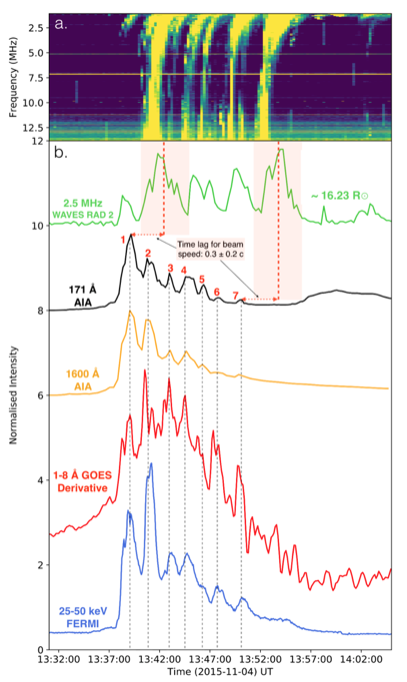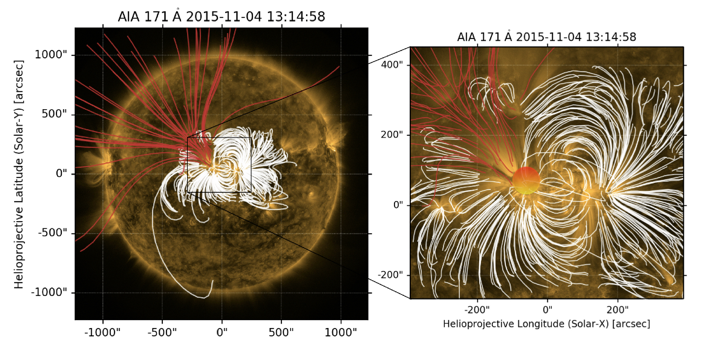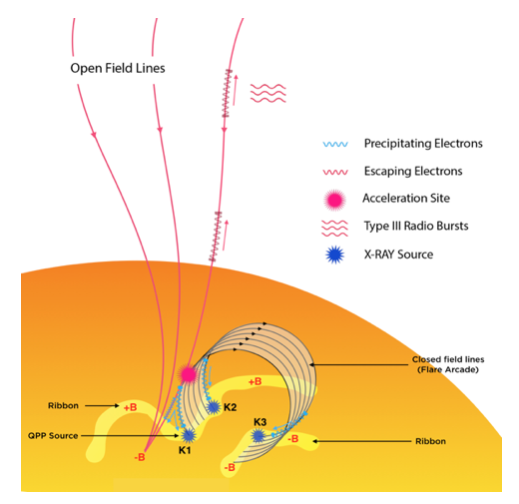Quasi-periodic pulsations (QPPs) are defined as intensity modulations in the flare electromagnetic radiation as a function of time. These modulations have been found to have characteristic periodicities that range from < 1 s up to several minutes.
QPPs were first associated with the impulsive phase of flares and observed in the hard X-ray (HXR) and radio wavebands (Parks & Winkler 1969). They have more recently been observed within the thermal component of flares and have been identified to persist into the decay phase (Dennis et al. 2017). Hence studies that explore signatures of QPPs across the entire electromagnetic spectrum are important to help us build a picture of their underlying driver.
Recent studies have determined that a lower limit of ~46 % of the X-class flares in the last solar cycle contained QPPs (Hayes et al. 2020). Despite the ubiquity of QPPs in flares, the underlying mechanism that produces them remains unknown. Several models have been proposed as explanations for the presence of QPPs, which are typically categorized as oscillatory or self-oscillatory processes (McLaughlin et al. 2018).
Oscillatory processes encompass mechanisms in which magnetohydrodynamic (MHD) oscillations or waves modulate the electromagnetic emission, or stimulate magnetic reconnection on a time-dependent basis. These processes allow for seismological possibilities of using QPPs to probe solar and stellar flare sites to extract properties such as the electron density, magnetic field, and flare loop lengths.
Self-oscillatory processes are interpreted as a manifestation of time-dependent, intermittent magnetic reconnection. These processes allow for the existence of broad-band QPPs and if found to be occurring, would provide new insight into the nature of energy release in flares.
Observations & Results
In this work, we investigate a GOES M3.7 flare that occurred on 2015 November 4. The flare exhibited pronounced QPPs across a broad-band of wavelengths. We identify QPPs in the X-ray, low-frequency radio, and extreme ultraviolet (EUV) wavebands.
We determine that these QPPs are a consequence of intermittent particle acceleration, likely due to “bursty” magnetic reconnection. At the energy release site, accelerated electrons precipitate toward the chromosphere to produce the X-ray and EUV pulsations. The electrons accelerated towards interplanetary space escape along open magnetic field lines, resulting in low-frequency radio pulses in the form of type III radio bursts.

Figure 1 – (a) shows the dynamic spectrum of the radio emission containing a sequence of type III radio bursts and Figure 1(b) shows the EUV, soft X-ray (SXR), and HXR light curves in which we identify seven pulsations. The EUV light curves were extracted from the QPP source region identified in Figure 2. The HXR, SXR, and EUV QPPs were found to have the same period of ~2 minutes, indicating a common progenitor.
The green light curve in Figure 1(b) shows a slice from the dynamic spectrum at 2.5 MHz. Using an electron density model, we estimated the height at which this radio emission was emitted: ~ 16 solar radii. Lines drawn from the peaks of pulses 1 and 7 from the 171 Å curve indicate the time delay required for the electron beams to reach this height from the flare site. This analysis suggests that the beam speeds are equal to the typical value of ~0.3 c for type III radio bursts. Hence, we have related QPPs observed in the SXR, HXR, EUV, and low frequency radio regimes.
Locating the QPP Source

Figure 2 – Spatial analysis of the QPPs. Left: an AIA 171 Å image with RHESSI 35-70 keV image contours overlaid. The light curves on the right show the HXRs (full Sun) with the EUV emission extracted from two of the kernels marked in the image, showing K1 to be the primary source region.
RHESSI imaging was employed to determine where the non-thermal HXRs originated. It was found that there were three HXR sources on the map which are labelled as K1, K2, and K3. These sources are shown in red overlaid on the 171 Å SDO/AIA image in Figure 2.
To determine the location within the flare site predominantly producing the QPPs, we integrated the emission from each EUV image over each region of the active region using various kernel sizes, generated light curves for each of these kernels for the duration of the flare, and compared the profiles of the time series to that of the HXR emission. The emission from K1 produced the most prominent QPPs and was found to yield a periodicity that best matched the HXR pulsations.
A natural escape route

Figure 3 – PFSS extrapolation showing the geometry of the magnetic field lines of the flaring region overlaid on the AIA 171 Å image.
The QPP source region, K1, is associated with open magnetic field lines, identified in the potential field source surface (PFSS) extrapolation shown in Figure 3. This magnetic field geometry allows for a mechanism for the escape of the electrons responsible for producing the radio emission.
Conclusions
 Figure 4 – Cartoon of the flaring region illustrating the likely mechanism through which we observe the episodic particle acceleration resulting in QPPs in EUV, radio, SXR, and HXR.
Figure 4 – Cartoon of the flaring region illustrating the likely mechanism through which we observe the episodic particle acceleration resulting in QPPs in EUV, radio, SXR, and HXR.
We interpret the QPPs identified in this flare in terms of pulsed electron acceleration caused by time-dependent intermittent reconnection. In Figure 4 we show a cartoon scenario of the flare site to illustrate how the QPP sources are related to the magnetic field configuration. Following each burst of electron acceleration, those that escape upward along the open magnetic field lines result in the type III QPPs, and those that travel along closed lines precipitate in the chromosphere to cause the QPPs we observe in hard X-ray and EUV.
This work provides new evidence that oscillatory or time-dependent reconnection can naturally generate QPPs, providing an explanation for their presence across the entire spatial range of flaring emission. It shines light onto the nature of energy release in flares, provides insight into how QPPs be can localised to specific regions of flare sites, and that QPPs can manifest over vast distances via multiple emission mechanism.
Future work to investigate the details and conditions necessary for the triggering of magnetic reconnection in this bursty fashion is required.
Based on the recent paper: Brendan P. Clarke et al., 2021, ApJ, 910, 123
References
Dennis, B. R. et al. 2017, ApJ, 836, 84
Hayes, L.A. et al. 2020 ApJ, 895, 50
McLaughlin, J. A. et al. 2018 SSRv, 214, 45
Parks, G., & Winckler, J. 1969 ApJL, 155, L117
*Full list of authors: Brendan Clarke, Laura A. Hayes, Peter T. Gallagher, Shane A. Maloney & Eoin P. Carley
